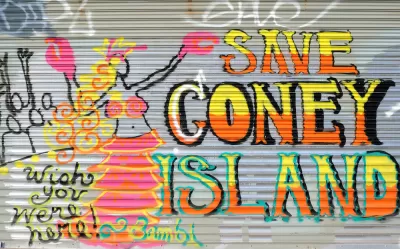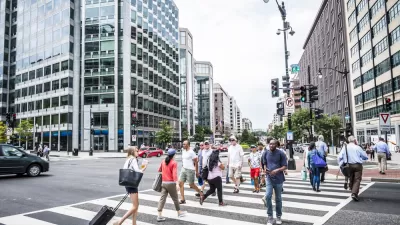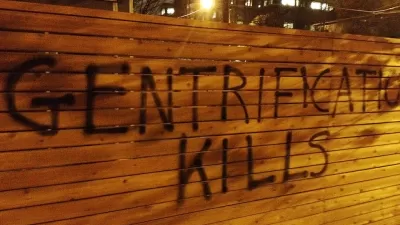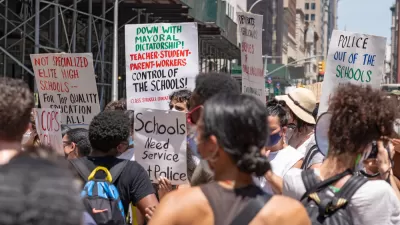Governing's recent study of gentrification systematically exaggerates gentrification in a variety of ways.

The ordinarily responsible Governing magazine is running a study of gentrification on its website; the study purports to show high levels of gentrification in some cities. For example, the study claims that 29 percent of New York's poor census tracts have gentrified.
But the methodology of this study is a bit suspect. It measures gentrification not by income or poverty, but by two criteria: (1) rising home values and (2) the growth of college graduates. The first method means that if people are growing poorer due to high housing costs, their neighborhood must be growing richer. It seems to me, however, that a neighborhood is not richer just because it is experiencing a housing bubble, or because it did not suffer a housing bust.
To be sure, there is some relationship between housing values and gentrification: other things being equal, higher incomes lead to higher demand lead to higher home prices. But other things are never equal: for example, in a small census tract with only a few houses, one or two condo buildings can skew average values upward.
The second element is also a less than ideal measure. In 1970, only 10 percent of Americans over 25 were college graduates—a percentage that nearly tripled over the following 40 years. Between 2000 and 2010, the percentage of college graduates increased in every single state. As college educations have become more common, I suspect that even the poorest places probably have more college graduates than they did a few decades ago. So if more college graduates=gentrification, one will naturally find gentrification everywhere. (To be fair, Governing used growth in college graduates rather than the raw number of graduates as a measure of gentrification; however, even less than explosive growth qualified census tracts as gentrifying. For example, one Kansas City census tract was classified as "gentrified" although its percentage of college graduates increased from 6 percent all the way up to 11 percent- a level only slightly higher than that of the city's poorest areas. The study described another neighborhood as "gentrified" because the percentage of graduates tripled- overlooking the fact that the percentage increased from 3 percent to a still-dismal 9 percent). Similarly, in Atlanta the dirt-poor Vine City neighborhood (where the median household income was under $20,000) was counted as "gentrified".
If gentrification means "more rich people" or "fewer poor people," it seems to me that a more appropriate measure of gentrification should address income: did incomes rise or fall? Did poverty rise or fall? And even if poverty fell, is a neighborhood's poverty rate anywhere close to suburban levels, or did an place with super-high poverty rates merely become a place with high poverty rates?
In addition, it seems to me that any study of gentrification should study degentrification as well: that is, to what extent were rising incomes in some urban neighborhoods balanced out by falling incomes and rising poverty in other neighborhoods? I suspect that a study considering this element would yield radically different results.*
*In particular the City Observatory website contains a wealth of data (pun intended) on neighborhood poverty.

Alabama: Trump Terminates Settlements for Black Communities Harmed By Raw Sewage
Trump deemed the landmark civil rights agreement “illegal DEI and environmental justice policy.”

Planetizen Federal Action Tracker
A weekly monitor of how Trump’s orders and actions are impacting planners and planning in America.

Why Should We Subsidize Public Transportation?
Many public transit agencies face financial stress due to rising costs, declining fare revenue, and declining subsidies. Transit advocates must provide a strong business case for increasing public transit funding.

Understanding Road Diets
An explainer from Momentum highlights the advantages of reducing vehicle lanes in favor of more bike, transit, and pedestrian infrastructure.

New California Law Regulates Warehouse Pollution
A new law tightens building and emissions regulations for large distribution warehouses to mitigate air pollution and traffic in surrounding communities.

Phoenix Announces Opening Date for Light Rail Extension
The South Central extension will connect South Phoenix to downtown and other major hubs starting on June 7.
Urban Design for Planners 1: Software Tools
This six-course series explores essential urban design concepts using open source software and equips planners with the tools they need to participate fully in the urban design process.
Planning for Universal Design
Learn the tools for implementing Universal Design in planning regulations.
Caltrans
Smith Gee Studio
Institute for Housing and Urban Development Studies (IHS)
City of Grandview
Harvard GSD Executive Education
Toledo-Lucas County Plan Commissions
Salt Lake City
NYU Wagner Graduate School of Public Service






























